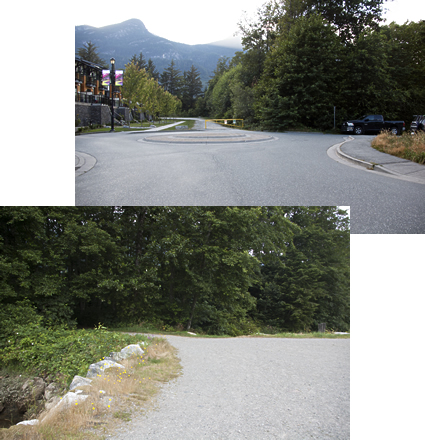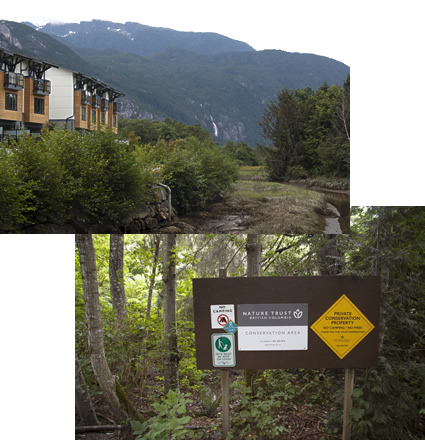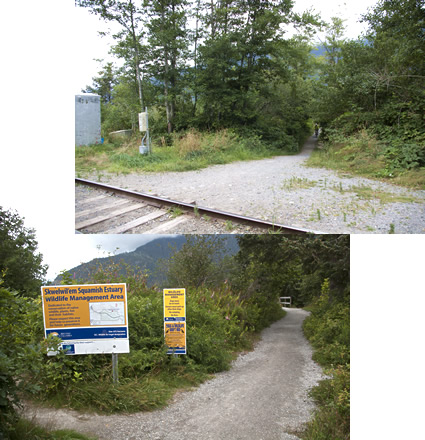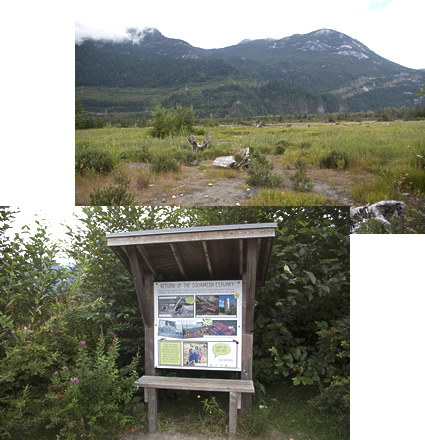
Walking Squamish’s Estuary Trail
The Squamish Estuary, made up of land and waters to the west of the railway track, is a restricted conservation area. The estuary is popular with hikers, dog walkers, mountain bikers, kayakers, paddleboarders, kiteboarders and anglers. The estuary trails are particular favourite of guests of August Jack Motor inn.
A short walk, 5 blocks northwest on Main Street, and you’ll be on the gravel dyke trail. There’s a roundabout at Main Street and 5th Avenue, and you’ll see the Soleil at Coastal Village townhomes to the left. If you decide to take the car, 5th Avenue usually has some parking available on the gravel shoulders. At the dyke trail, you’re going to turn left, and within 50 metres you’ll see the opening to the trail leading to the railway tracks.


As you turn right onto the short gravel connector trail, behind the Soleil at Coastal Village townhomes, you should be able to see Shannon Falls in the distance. On the right side of the connector trail, you’ll pass a Nature Trust British Columbia sign, with notices to pet owners, to keep dogs on a leash at all times.
You’ll soon arrive at the railway tracks and the trailhead for the Blue Heron Trail and Squamish Estuary Trail network. The Blue Heron is topped with gravel, and offers excellent drainage, for a relatively dry surface even on rainy days.
Bird watchers can often be seen, looking out over the wetlands to the left of the trail, with binoculars and telephoto lenses.


There are three bridges on the first Blue Heron / Swan Trail section, at creek crossings. As the trail leaves the alder forested section, there’s a right turn into an interpretive area. Here you’ll find two information boards that double as rest benches.
The Squamish Estuary is located on the tip of Howe Sound. More than two hundred species of wintering and migrating birds are here to discover, as well as other wildlife. Bird species include geese, blue heron, belted kingfisher, trumpeter swan and crows. Mammals include black bear, cougar, coyote, black-tailed deer, moles, voles and rabbits.
The terrain opens up to large expanses of cattails and marshland, wetlands and tidal mudflats. The mixing of freshwater from the adjacent Squamish River with tidal saltwater, twice daily, creates an abundant ecosystem. Plantlife, birds, fish and salmon fry find plenty of nutrients in its brackish water.


The Swan Trail offers some of the best unobstructed views of the Stawamus Chief. For much of the year, the marshland is dotted with wildflowers, set before a backdrop of bullrushes and other wetland sedges.
The trail’s second bridge crosses the Estuary Trail’s clearest creek, making this a popular place for the dog to take a cooling dip in the summer.
After passing the second information board/bench, the trail takes another sharp right and approaches the third bridge. Many trail runners and walkers will turn back at the bridge.
Upon crossing the bridge, you’re presented with two options. You can remain on the Swan Trail, to complete the full loop, or turn right onto the Old North Dyke Trail, which also loops back to the tracks and trailhead.

Old North Dyke Trail Loop
The Old North Dyke Trail “short loop” is arguably the most interesting choice. It’s become a favourite with mountain bikers, with small ramps added to bridges and boardwalks to provide easier tire access, and technically challenging root-covered paths.
The trail passes right through the bog, and in one section there are recently added burl ‘pavers’ placed in the marsh to be used as stepping stones.
Swan Trail / Cattemole Creek Trail Loop
Taking the longer Swan Trail / Cattemole CreekTrail route offers a tranquil flat gravel trail under a canopy of alder and spruce trees, with views of the water to the left of the path. It’s common to see paddleboarders in the channel.
You’ll come to a fork in the trail, and you want to turn right towards Bailey Road. Within a minute or two, of the trail junction, you’ll find yourself on Bailey Road. You want to turn right, and then walk about 100 metres, to where Cattemole begins. Cattemole Creek Trail passes through lush old-growth forest, and the short trail will take you to the tracks, where you’ll turn right and walk back to the trailhead.

